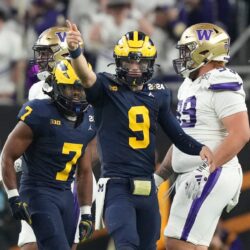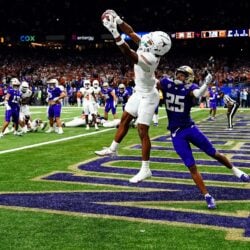Junior Seau, Brings Face To Problem Of Brain Injuries
The NFL world was rocked yesterday with news that Junior Seau, standout linebacker for the San Diego Chargers, Miami Dolphins and New England Patriots had reportedly committed suicide. Seau died from an apparent gun-shot wound to the chest and the rumors have abounded that like former Chicago Bear Dave Duerson, Seau had hoped that his brain would be examined in the study in Boston where the results of repeated concussions are being charted. But that is just speculation at this point.
One common theme from exposure to repeated concussions are periods of black depression followed by suicide attempts. This has been a common theme among former NFL players as well as returning soldiers from combat in the Middle East.
Seau back in 2010 was accused of spousal abuse after a fight with his girlfriend, after being released from jail, his SUV drove off a bluff on the beach in San Diego. At the time, Seau claimed to fall asleep, no drugs or alcohol were found but this could have perhaps been a sign of things to come.
The number of military personnel suffering from concussions through exposure to explosions, bombs, weapons firing etc. has to be astronomically higher. However, given the 10+ years of wars in Iraq and Afghanistan and soldiers being subjected to multiple tours of combat have increased the chances of experiencing multiple concussions in a relatively short amount of time.
But the problems run deeper, in amateur scholastic sports, that there are a reported 300,000 injuries consisting of a Traumatic Brain Injury (TBI) with over 60,000 occurring in high schools alone. It is estimated that 15% of student athletes will suffer some sort of concussion injury every year. 63% of these injuries will occur in football and further, it is estimated that nearly 1 in 5 football players will suffer a concussion each year. The younger the person is, the bigger the chance of a repeat injury, for athletes or military members under the age of 21, the chances of having another concussion once already injured are 4 – 6 times more likely.
Concussion refers to a traumatic force that is applied to the brain during any type of bone jarring collisions often found in contact sports such as football and hockey. But many times, it can be found in seemingly “safer” sports such as soccer and baseball. Concussions are sometimes referred to as an “invisible injury”. That’s because unlike a common knee or foot injury where a player is seen on crutches, there are no visible signs of injury. Is there a way to make athletes safer on the field without taking away what the game is essentially, a violent contact sport?
What is a concussion is exactly? A concussion is the result of significant force or trauma applied to the head of an athlete. Symptoms of concussion are often quite different, and vary for each person suffering from one, which often makes it harder to identify although there are a host of symptoms most frequently attributed to concussion. An athlete doesn’t need to lose consciousness in order to be diagnosed with a concussion. Some general symptoms encountered with a concussion include:
- Poor memory & inattention
- Headache or "pressure" in the head
- Nausea or vomiting
- Balance problems or dizziness
- Double or blurry vision
- Sensitivity to sound or light
- Concentration or memory problem
- Confusion
- Feeling sluggish, hazy, foggy, or groggy
Doctors use both computerized cognitive testing and standardized protocols for measuring recovery from sports concussion. A key to this is his consultation with both trainers and coaches following a concussion to assure for managed return to play.
Cognitive testing or cognition refers to the sum of all thinking, planning, and problem solving within the brain. Traumatic brain injury has the potential to alter cognitive skills such that these "automatic" processes no longer work as efficiently as they once did.
The tests consists of identifying words, shapes and colors that flashed on a computer screen for the test subject, then words, shapes and colors are played back and the tester has to respond whether or not it was part of the original group flashed to him.
Once the baseline is established, he can re-administer the test when a subject is recovering from his injury. He showed some startling test results from subjects who although were given medical clearance to resume activities, their brain functions were still far from recovered.
However, we’ve heard stories of trainers on professional sports teams encouraging players to “not do their best” during cognitive testing, therefore allowing them to score higher after a brain injury and allow them to return to action much faster than normally would be allowed. This practice must be stopped and players need to realize that while they may return to game action a week or two earlier, the damage they can do, long-term to their brains, may be permanent.
Once an athlete or soldier is injured with a concussion, the people immediately involved with the medical/administrative care of the injured need to look for the following:
- Increased problems paying attention/concentrating
- Increased problems remembering/learning new information
- Longer time required to complete tasks
- Increase in physical symptoms (e.g., headache, fatigue) during mental tasks
- Greater irritability, less tolerance for stressors
Once an injured person is cleared to resume normal activities, his or her play has to be done gradually with no further symptoms.
- Rest
- Aerobic exercise (.e.g., stationary bicycle)
- Sport Specific training (e.g., running, skating)
- Non-contact drills (includes cutting and other lateral movements)
- Full-contact controlled training
- Full-contact game play
This is a gradual process and one that we see all the time violated in the NFL and NHL. We see a player concussed on Sunday, cleared by doctors on Tuesday or Wednesday and return to practice by the end of the week. Where doctor’s involved with traumatic brain injury frequently state, it should be done over a period of weeks not hours or days.
If the NFL/NHL is truly worried about player safety, they need to follow the guidelines of the doctors who study this medical condition and not rush the players back before they are ready. If the rules regarding players being placed on the “injured reserve list” need to be tweaked allowing players to return in 4-6 weeks during a season, then it should be done. Rushing players back from brain injuries are not helping either the team or the player in the long run.
The NFL is trying to crack down on the incidents of concussions or traumatic brain injuries by punishing those players it deems, “headhunters” or people who try to knock a person out. The recent suspensions of members of the New Orleans Saints coaches and players for the recent “Bounty-Gate” are well known. But the Saints are hardly alone in this matter. There are the frequent offenders to this rule and those players and incidents need to be rooted out of the league.
Those players who took part in the Bounty Program in New Orleans have all vowed to appeal their suspensions. I don’t know if it will happen or not, it’s not my place to be the judge in these matters. But if I am the NFLPA, how can you defend this action and yet go to the league screaming for better player safety and long-term health benefits?
The NFL needs to take serious action in their quest for player safety, but of the trickle-down effect it has upon colleges, high schools and youth football programs. The league needs to remove, permanently these types of plays and players who target other players heads to make the “highlight” film of the week. The sports networks are as much to blame, on one hand lambasting player conduct and on the other showing it time and again with the requisite “BOOM!” voice over.
While players such as Junior Seau, bring a national face to the problems of traumatic brain injury and what it can cause, it’s happening right now, in your town, your high school and your college. With players suffering concussions throughout their playing lives, it is a problem that will not go away. The game itself is a violent one and doesn’t need to be even more so with over the top actions. If the NFL takes a stand on this issue, it will affect every level of football down the line.
Players need to wake up and take notice…the brain you save may be your own.









